0% found this document useful (0 votes)
27 views14 pagesChapter I: Computer Abstractions and Performance
This document is a comprehensive overview of computer architecture, covering topics such as classes of computers, layers of operation, performance metrics, and key technological trends. It discusses the evolution of computing from personal computers to cloud computing and highlights the importance of abstraction in simplifying design. Additionally, it addresses the components of computers, including processors, memory, and networks, while emphasizing the significance of performance measurement and technology advancements.
Uploaded by
anhtnh.23ba14015Copyright
© © All Rights Reserved
We take content rights seriously. If you suspect this is your content, claim it here.
Available Formats
Download as PDF, TXT or read online on Scribd
0% found this document useful (0 votes)
27 views14 pagesChapter I: Computer Abstractions and Performance
This document is a comprehensive overview of computer architecture, covering topics such as classes of computers, layers of operation, performance metrics, and key technological trends. It discusses the evolution of computing from personal computers to cloud computing and highlights the importance of abstraction in simplifying design. Additionally, it addresses the components of computers, including processors, memory, and networks, while emphasizing the significance of performance measurement and technology advancements.
Uploaded by
anhtnh.23ba14015Copyright
© © All Rights Reserved
We take content rights seriously. If you suspect this is your content, claim it here.
Available Formats
Download as PDF, TXT or read online on Scribd
/ 14
























































































